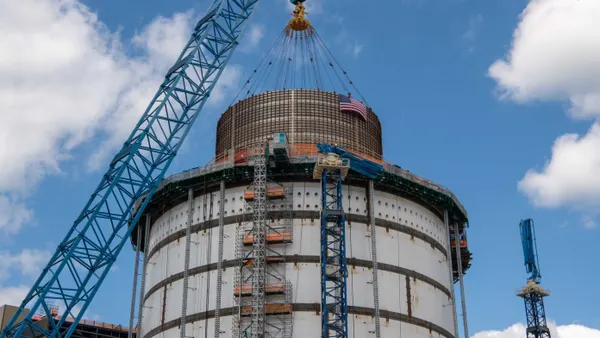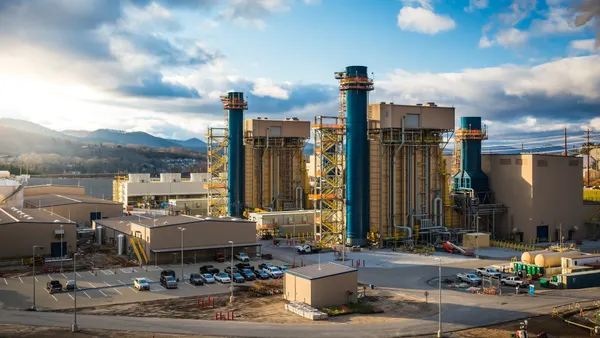Electric transmission in the U.S. historically has been designed to deliver power from central station power plants to the load centers. Transmission development was driven by reliability needs and load growth fueling efficient transmission investment to meet the societal needs of its time.
Today, the country is moving toward a clean energy economy to increase adoption of renewable generation resources. These resources are dispersed, often being built in remote areas, which is challenging the established transportation pathways to move electric power to end-users—the electric transmission system.
Due to the generation assets being built in remote areas where renewable resources are the richest, adequate transmission often does not currently exist and require an extensive infrastructure buildout to meet the future clean energy needs.
The Department of Energy (DOE) published findings suggesting a 64% increase of today’s transmission infrastructure is needed to support the high clean energy growth fueled by investments from the Infrastructure Investment and Jobs Act (IIJA) and Inflation Reduction Act (IRA).
Transmission development is lengthy and complex. Without proper transmission development, renewable resources may not be fully tapped to reach our goals. Recent orders from the DOE and Federal Energy Regulatory Commission (FERC) aim to address critical gaps in the development of electricity transmission projects to enable the grid to integrate renewables and meet growing power demands.
The biggest hurdles in the successful development of transmission projects have been related to permitting, interconnection, patchwork of regulatory requirements, and lack of mechanisms for comprehensive grid solutions. These recent orders focus on streamlining permitting processes, enhancing interconnection procedures, and improving long-term transmission planning to ensure reliability, efficiency, and cost-effectiveness.
In combination, the goal of these developments is to enable large-scale transmission development in a way that previous FERC orders couldn’t, and to allow the industry to move away from the inefficient, higher cost, and marginal project-by-project transmission solutions to meet the demands of large volume of renewables that are slated to interconnect to the grid.
What to know: Recent orders and rules
- DOE NIETC Designation Process: In Phase 2 of its National Interest Electric Transmission Corridors (NIETC) designation process, the DOE announced a preliminary list of 10 priority transmission corridors. The NIETC process aims to address congestion and constraints in the transmission system, which can impact the reliability and affordability of electricity. These potential NIETC areas are based on findings from DOE’s 2023 National Transmission Needs Study.
- DOE Coordinated Interagency Authorizations and Permits (CITAP) Program: This rule will establish the DOE as the lead agency to coordinate federal permitting processes for qualifying regionally significant onshore transmission infrastructure projects. This rule aims to make the permitting processes more efficient and cut the average time to permit a new transmission line from four years to two years.
- FERC Order 2023 – Revised Interconnection Procedures: Public utility transmission providers must adopt revised procedures for interconnecting both large and small generators to ensure reliability, efficiency, and transparency. This order also changes the bedrock principle of interconnection processing: “first come, first served" to “first ready, first served." The order is expected to reduce interconnection timing and costs, enhance market competition, and improve reliability which benefit consumers with lower wholesale prices.
- FERC Order 1920 – Long-Term Regional Transmission Planning: This order requires a long-term regional transmission plan every five years, using a 20-year horizon and scenario planning to identify transmission needs. It introduces methods for cost allocation and enhances coordination with states to ensure affordable electricity and grid reliability. It also allows for transmission project selections based on multi-value benefits to the grid.
- FERC Order 1977 – Backstop Transmission Siting Procedures: This order will bolster FERC’s transmission siting authority to help interstate transmission projects. It allows FERC to issue permits for transmission line projects in designated corridors when states have not acted on or have rejected an application. In conjunction with the DOE’s 10 recently proposed National Interest Electric Transmission Corridors (NIETCs), this order could impact proposed transmission line projects in those corridors.
How this impacts transmission development
These actions illustrate the growing importance that the federal government is placing on transmission development necessary to achieve the nation’s clean energy goals. The impacts of these actions include a better vision of the necessary transmission improvements provided by the 20-year planning horizon to fully enable the renewable generation build-out.
FERC begins to tackle one key hurdle of interregional transmission development—cost allocation—by requiring cost-allocation provisions to ensure all beneficiaries pay. Order 1920 recognizes the need for smart development by seeking to get the full benefit of existing transmission infrastructure by upgrading facilities, right-sizing, and giving consideration to grid-enhancing technologies. Notably, competition will remain as FERC Order 1920 did not reinstate a Federal Right of First Refusal (ROFR) but rather limited that right to right-size existing infrastructure.
The actions also seek to address permitting challenges that have long been a barrier to developers. Historically, developers have avoided building on federal lands due to extensive and difficult permitting processes, including NEPA approvals. However, the CITAP Program, FERC Order 1977, and other recent developments may change the business case making federal lands a more viable option for development.
Transmission developers may find additional opportunities from the increased planning horizon or the revised permitting processes. Incumbent utilities can prepare to secure the transmission build in their service areas by taking a strategic look at their processes and adapting them to a more competitive environment.
Competition is here to stay. The successful transmission developer will have adopted a competitive strategy and implemented processes to construct projects that deliver the full benefits to customers.
These actions do come with some inherent risk. Planning is based on assumptions, and long-term planning is based on long-term assumptions. The 20-year planning horizon introduces more uncertainty in assumptions that could lead to an overbuild of transmission or transmission built in the least optimal locations. There’s a risk of straining relationships with state authorities or causing conflicts with community stakeholders by exercising federal permitting authority in NIETC corridors. This could lead to inaction on federal authority, much as it did when NIETC corridors were designated in 2007, or it could lead to litigation that would tie up development for a long time. Although these new federal actions intend to make it easier to develop transmission, the complexities related to careful navigation, management, and coordination among state and federal agencies and stakeholders are likely to remain and may require innovative approaches.
Next steps for utilities and developers
Planning for and implementing large-scale transmission projects is complicated. The new regulatory landscape offers significant new opportunities for developers and incumbent transmission owners alike. But successful development will be driven by a strategy that focuses on creating customer value by delivering transmission projects with the greatest benefits, most cost effectively.
Utilities and developers can consider the following steps to prepare:
- Develop a transmission strategy that focuses on identifying and delivering the best solution for the customers. Include competitive strategy that accounts for risk temperament and internal competencies to develop the right approach to win in competitive solicitations.
- Develop effective methods to measure benefits in a multi-value framework to justify the cost effectiveness of planned development. Demonstrate value of projects through quantified benefits, including value to both sides of interstate or inter-regional projects when applicable.
- Plan for the increased volume of interconnection applications and assess the need for people, process, or technology changes to prepare for utility involvement in the interconnection process (i.e., data requests, system impact studies, facilities studies, interconnection agreements, etc.) to ensure applications advance successfully and expediently.
The evolving landscape of U.S. transmission planning aims to meet clean energy demands by addressing inadequate infrastructure through extensive upgrades and new construction. Recent DOE and FERC directives streamline permitting, enhance interconnection, and introduce long-term planning to overcome historical barriers. Success depends on navigating regulatory frameworks and adopting competitive strategies by utilities and developers.










